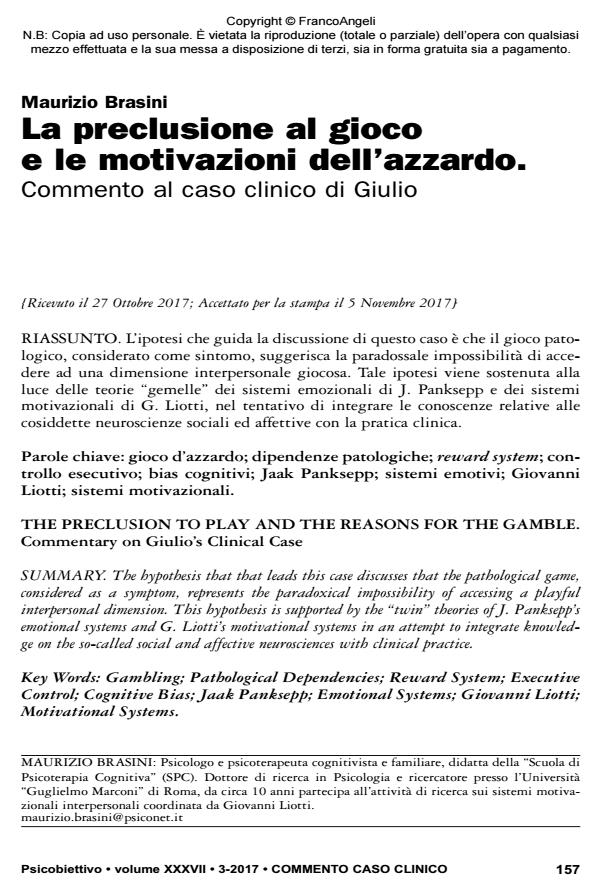The preclusion to play and the reasons for the gamble. Commentary on Giulio’s clinical case
Journal title PSICOBIETTIVO
Author/s Maurizio Brasini
Publishing Year 2017 Issue 2017/3
Language Italian Pages 6 P. 157-162 File size 92 KB
DOI 10.3280/PSOB2017-003009
DOI is like a bar code for intellectual property: to have more infomation
click here
Below, you can see the article first page
If you want to buy this article in PDF format, you can do it, following the instructions to buy download credits

FrancoAngeli is member of Publishers International Linking Association, Inc (PILA), a not-for-profit association which run the CrossRef service enabling links to and from online scholarly content.
The hypothesis that that leads this case discusses that the pathological game, considered as a symptom, represents the paradoxical impossibility of accessing a playful interpersonal dimension. This hypothesis is supported by the "twin" theories of J. Panksepp’s emotional systems and G. Liotti’s motivational systems in an attempt to integrate knowledge on the so-called social and affective neurosciences with clinical practice.
Keywords: Gambling; Pathological Dependencies; Reward System; Executive Control; Cognitive Bias; Jaak Panksepp; Emotional Systems; Giovanni Liotti; Motivational Systems.
- Alexander B.K., Coambs R.B., Hadaway P.F. (1978) “The effect of housing and gender on morphine selfadministration in rats”, Psychopharmacology, 6, 58(2): 175-9
- Anselme P., Robinson M.J. (2013) “What motivates gambling behavior? Insight into dopamine’s role”, Front. Behav. Neurosci., 7: 182.
- Freud S. (1927) trad. it.: “Dostoevskij e il parricidio”, in id., Opere, vol. 10, Bollati Boringhieri, Torino, 1978
- Griffiths M.D. (1994) “The role of cognitive bias and skill in fruit machine gambling”, British Journal of Psychology, 85: 351-369
- Lachmann F.M., Lichtenberg J. (1992) “Model Scenes: Implications for Psychoanalytic Treatment”, Journal of the American Psychoanalytic Association, 40, 1: 117-137
- Liotti G., Farina B. (2011) Sviluppi Traumatici, Raffaello Cortina, Milano
- Liotti G., Fassone G., Monticelli F. (2017) L’evoluzione delle emozioni e dei sistemi motivazionali, Raffaello Cortina, Milano
- Lobo D.S., Kennedy J.L. (2006) “The genetics of gambling and behavioral addictions”, CNS Spectrums, 11(12): 931-9
- Main M., Hesse E. (1990) “Parents’ unresolved traumatic experiences are related to infant disorganized attachment status: Is frightened and/or frightening parental behavior the linking mechanism?”, in Greenberg M.T., Cicchetti D., Cummings M. (eds.), Attachment in the preschool years: Theory, research and intervention, University of Chicago Press, Chicago, IL, pp. 161-182
- Panksepp J. (1998) Affective Neuroscience, Oxford University Press
- Panksepp J. (2011) “I sistemi emotivi del cervello e la qualità della vita mentale”, in Fosha D., Siegel D.J., Solomon M.F., Attraversare le emozioni, vol. 1, Mimesis, Milano, pp. 17-48
- Petry N.M., Blanco C., Auriacombe M., Borges G., Bucholz K. (2014) “An overview of and rationale for changes proposed for pathological gambling in DSM-5”, Journal of Gambling Studies, 30(2): 493-502
- Sàez I., Zhu L., Set E., Kayser A., Hsu M. (2015) “Dopamine Modulates Egalitarian Behavior in Humans”, Current Biology, 25: 912-919
- Set E., Saez I., Zhu L., Houser D.E., Myunge N., Zhong S., Ebstein R.P., Chew S.H., Hsu M. (2014) “Dissociable contribution of prefrontal and striatal dopaminergic genes to learning in economic games”, PNAS, 111, 26: 9615-9620.
- Shinobu K., King A., Hsu M., Liberzon I. (2016) “Dopamine-System Genes and cultural Acquisition: The Norm Sensitivity Hypothesis”, Current Opinion in Psychology, 8: 67-174
- Skinner B.F. (1953) Science and human behaviour, Macmillan, New York
- Tversky A., Kahneman D. (1974) “Judgment under uncertainty: Heuristics and biases”, Science, 185 (4157): 1124-1131. PMID 17835457.
Maurizio Brasini, La preclusione al gioco e le motivazioni dell’azzardo. Commento al caso clinico di Giulio in "PSICOBIETTIVO" 3/2017, pp 157-162, DOI: 10.3280/PSOB2017-003009